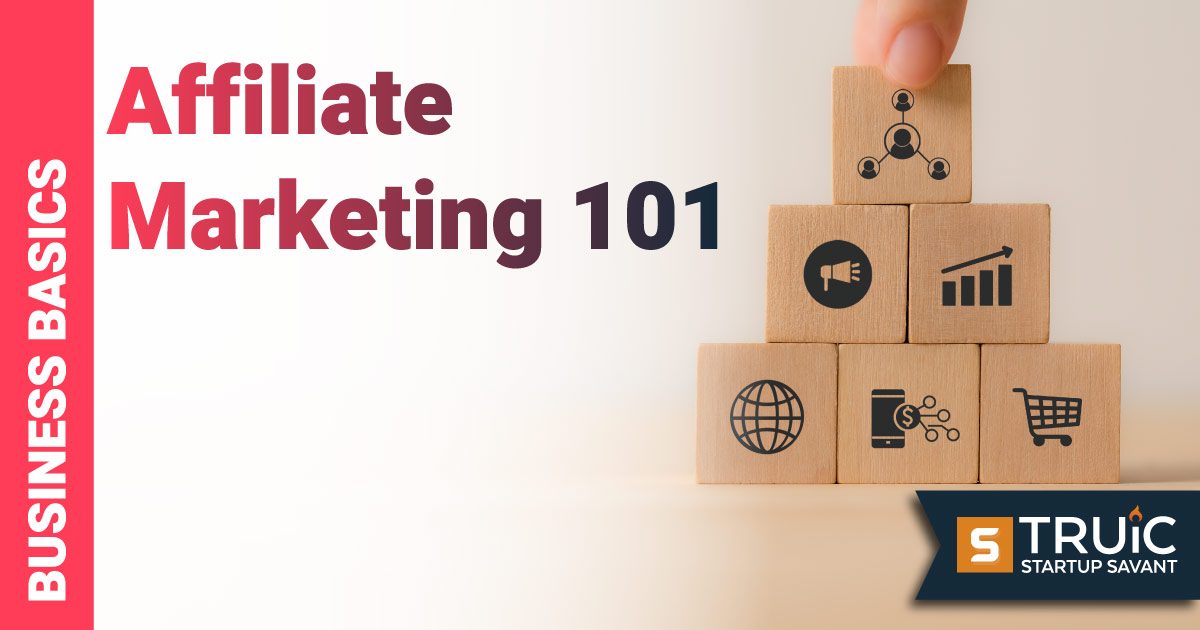Affiliate Marketing 101

Last Updated: By TRUiC Team
The rise of social media has given way to a brand-new digital marketing method known as affiliate marketing. In addition to presenting companies with promising new marketing avenues and an excellent way to build social proof for their brands, affiliate marketing can also be a highly rewarding career for those who have managed to build large social media followings.
So, how do you get started as an affiliate marketer, and how does affiliate marketing work? This article covers everything you need to know to help you get started with turning your social media audience into a source of profit, including the benefits of affiliate marketing and the steps you should follow for affiliate marketing success.
What Is Affiliate Marketing?
Companies have relied on partnering with organizations that can reach large audiences to advertise their products and services since the advent of magazines and newspapers. Up until the past decade or so, however, the ability to reach massive audiences was limited to media outlets and superstar celebrities.
Today, social media platforms such as Facebook, Instagram, YouTube, and Twitter provide anyone with internet access the opportunity to build an audience of followers. This capability has given rise to what is known as "social media influencers" — individuals who leverage their social media following in order to profit from affiliate marketing.
To make money from affiliate marketing, social media influencers partner with companies looking to advertise their products and services to create promotional content that they are paid to publish to their audience of followers. This promotional content can come in a variety of different forms, from promotional posts to something as simple as wearing a branded shirt during a YouTube video.
Social media influencers can span the spectrum from niche influencers with just a few thousand influencers to household name mega-influencers with millions of followers. The more followers that an influencer has, the more they can expect to be paid for affiliate marketing promotions. However, as we will discuss further in the next section detailing the specifics of how affiliate marketing works, audience size is not the only factor that determines how much an affiliate marketer will earn.
For those who have a knack for creating engaging social media content, affiliate marketing can be a highly lucrative venture. Best of all, it's something that almost anyone can find success at with the right skills and perhaps a little good fortune regardless of their location or educational background.
How Does Affiliate Marketing Work?
Companies searching for social media influencers to partner with utilize a variety of online platforms designed to connect influencers with brands seeking advertisement opportunities. When choosing an influencer to partner with, companies will consider several different factors, including the demographics of the influencer's audience, the size of their audience, the style of their content, and the past performance of their social media posts.
Once a company has found an influencer that they would like to work with, a contract between the two parties will be created. A contract between an influencer and the company hiring them will include specifics regarding the nature of the promotional posts that the influencer is expected to create and publish and how much they will be paid in return.
In most cases, influencers are paid a flat rate for publishing promotional content. However, it is also common for influencers to be paid a commission based on how many sales their promotion generates or to be paid a variable rate based on how the promotional posts perform.
The most important factor in determining how much an influencer gets paid is the size of their audience; a mega-influencer capable of reaching millions of people across the world is obviously going to command a much higher fee for promotional posts than a micro-influencer with just a few hundred followers. However, there are several other factors that can impact how much an influencer gets paid as well.
The first of these factors is the type of content that they produce. Simply publishing a one-paragraph Twitter post promoting a brand is not going to earn an influencer as much money as creating a full-length YouTube video reviewing a brand's product. In the latter scenario, brands would pay more even if all other factors are equal both to compensate the influencer for the time and effort it takes to create more complex content such as videos and due to the fact that lengthier, more complex content often allows for more effective messaging.
Another factor that can impact how much an influencer earns is the demographics of their audience. While a company's preferred target audience will differ from company to company, there are certain audience demographics that are more lucrative than others. The 18-34 age group, for instance, has long been considered the most profitable demographic to advertise to, and social media influencers with lots of followers in this age range will typically command higher affiliate marketing rates.
Finally, the performance of an influencer's past content can certainly impact how much money they are able to charge for promotional posts. An influencer with 50,000 followers that has a high engagement rate may be able to receive as much or more money for promotional posts than an influencer with twice as many followers but a low engagement rate.
Common Types of Affiliate Marketing
Affiliate marketing is broken down into three main categories: unattached affiliate marketing, related affiliate marketing, and involved affiliate marketing.
Unattached affiliate marketing is defined as an advertising model in which the affiliate marketer has no real connection to or expertise on the product that they are promoting. A comedic social media influencer promoting a brand of energy drinks would be one example of unattached affiliate marketing — they don't have any real expertise on the energy drinks that they're promoting, but expertise is not required to get the message across in this example.
With related affiliate marketing, the influencer does have some relationship with the product that they are promoting. A YouTuber with a woodworking channel promoting a brand's line of woodworking tools would be an example related to affiliate marketing. In related affiliate marketing, though, the influencer does not actually have direct experience with the product that they are promoting but rather general expertise in the product's niche.
With involved affiliate marketing, the affiliate marketer has direct experience with the product that they are promoting and are often provided with the product well ahead of their scheduled campaign so that they have plenty of time to gain hands-on experience with it. A fitness blogger publishing an article reviewing their first-hand experience with a brand's workout equipment would be one example of involved affiliate marketing.
Benefits of Affiliate Marketing
The benefits of affiliate marketing extend to both companies and social media influencers. For companies, affiliate marketing provides an avenue to reach potential customers that they might not be able to reach through traditional marketing methods.
The biggest benefit of affiliate marketing for companies looking to promote their products or services, though, is the fact that affiliate marketing provides brands with a much higher degree of social proof than other advertising methods. People are far more likely to listen to recommendations from personalities that they know and trust than they are to be swayed by a company's own ads and promotional content.
Statistics on affiliate marketing bear this fact out, with 74% of US online shoppers checking multiple affiliate sites before they make a purchase, according to research from CyberCash Worldwide.
For the influencers getting paid to publish promotional posts, affiliate marketing creates a simple and straightforward way to profit from a large audience of engaged followers. Aside from affiliate marketing, the only real way for people to profit from a large online audience is to sell products under their own brand.
While leveraging your social media audience to launch your own line of products can certainly be a profitable venture, it's also something that requires a lot of time, expertise, and capital. With affiliate marketing, the barrier to entry is much lower.
Examples of Affiliate Marketing
Given the rapid rise in popularity that affiliate marketing has experienced over the past few years, there's a good chance that not a day goes by that you won't see at least one instance of affiliate marketing content. Here are a few prolific affiliate partners for influencers looking to get started.
The Amazon Associate Program is perhaps the most prolific example of an affiliate marketing program, with Amazon paying up to a 10% commission on sales generated from an influencer's promotional content. Amazon also offers a companion “Amazon Influencer” program that is available to influencers with especially large audiences.
Skillshare is another company with a large affiliate program, which is why there's a good chance you've probably seen a YouTuber promoting Skillshare in the past if you spend much time on YouTube. With the Skillshare affiliate program, influencers are able to earn a commission on both free trial signups and paid subscriptions.
If you are searching for an affiliate program with especially generous commissions, Leadpages' Affiliate Program is well worth checking out. At a minimum, you will earn 10% commissions on sales of Leadpages' lead generation tools that your content generates, with commissions reaching as high as 50% for certain products.
These of course are just examples of a few more prominent affiliate programs, and affiliate marketers are able to find opportunities to partner with brands ranging from small, local businesses to international corporations.
How to Get Started With Affiliate Marketing
If you would like to get started making money as an affiliate marketer, the steps you will need to follow are relatively straightforward even if they aren't always that easy to accomplish. Complete every step on the following list and your career as an affiliate marketer and you are on your way to generating a substantial income.
Step 1: Build a Large Audience of Dedicated Followers
The first step to succeeding as an affiliate marketer is by far the most difficult to achieve. If you are able to build a large or even relatively large audience of followers who routinely engage with the content that you publish, then the rest of the steps required to make money as an affiliate marketer will come quite easily.
As for how to go about building the type of audience needed to succeed as an affiliate marketer, you'll want to start by defining your own brand and target audience. From there, your goal should be to create content that is as interesting and engaging as possible. If you are talented enough as a content creator and committed to learning strategies for growing a social media following, then your audience is bound to grow over time.
Step 2: Sign Up for Affiliate Programs
Once you have an audience that is large enough to qualify you for affiliate programs, signing up for programs such as the Amazon Associate Program Program or the Leadpages' Affiliate Program is an easy way to start earning money through affiliate marketing.
As commission programs, these programs make earning money as simple as publishing a unique link to your audience in whatever form you wish in order to receive a commission on every sale that your link generates.
Step 3: Sign Up for Affiliate Marketing Platforms
Online platforms such as Upfluence and Aspire allow social media influencers to create profiles that can be found by brands searching for influencers to partner with. If you would like to create promotional content that extends beyond simply earning commissions on sales generated through a promotional link then you will need to partner with brands directly using one of these platforms.
Step 4: Manage Your Brand and Profit
Once you start earning money as an affiliate marketer, it's important to keep in mind that your work keeping your audience engaged and coming back for more is far from over. If what you are doing is spamming your followers with promotional post after promotional post then it isn't going to take long for you to lose their trust and interest.
Whatever approach you take to grow a large audience of engaged followers in the first place is one that you must continue to prioritize even after the affiliate checks start rolling in. In other words, it is still essential to manage your own brand and provide your audience with the high-quality content that they expect for the duration of your career as an affiliate marketer.
Frequently Asked Questions
How do I start affiliate marketing?
Building an audience is the first step to succeeding as an affiliate marketer. Once you have managed to create an audience of at least a few thousand engaged followers, profiting as an affiliate marketer is as simple as signing up for affiliate programs and/or partnering with brands to produce promotional content via affiliate marketing platforms designed to connect brands with influencers.
How much money can you make as an affiliate marketer?
Affiliating marketing is something that can earn you anything between a little extra spending cash each month and millions of dollars per year depending, for the most part, on the size of your audience. According to data from Investopedia, 9% of affiliate marketers earn more than $50,000 per year.
How does an affiliate marketer get paid?
Affiliate marketers can be paid based on a variety of criteria, including flat-rate fees for publishing promotional content, variable fees based on how many clicks and impressions their continent generates, and commissions on the sales that their content generates.


